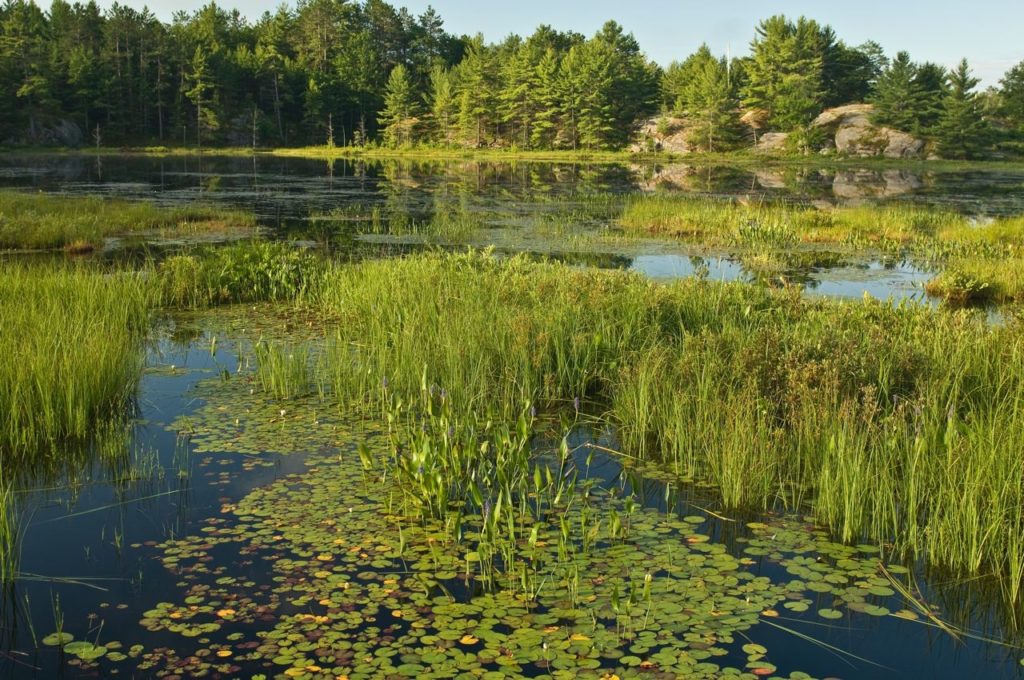How important is that wetland?
By Peter Sale

You’ve all seen wetlands. There are lots of them in Muskoka. Marshy, boggy, mosquito-infested, noxious places; neither a lake nor dry land; what good are wetlands, and do we need to protect them?
Yes! Muskoka’s new Official Plan is quite clear on that. Development is not permitted in provincially significant wetlands and can only occur in other wetlands after an environmental impact survey (EIS) confirms that the planned development or alteration will have no negative impacts on the wetland or on its ecological functions. The Official Plan also notes climate change impacts on wetlands will require increased restrictions on development of adjacent land as climate changes.
But are all wetlands equally important? Could we get by with slightly fewer? Or could we infill and develop the edges of a wetland without detriment to environmental quality? Just because Nature left a place a bit boggy, do we have to leave it that way?
Consider all the things wetlands do for us. As part of our natural capital, wetlands provide many valuable ecosystem services to people. They provide critical habitat for valued fish and waterfowl and for 90% of our species at risk. They retain, sequester, break down and make biologically available the sediments, phosphates, nitrates and many other chemicals carried by runoff from land that would otherwise pollute our waters. They recharge groundwater stores and sequester large quantities of carbon in peat and soils, carbon that would otherwise be released to the atmosphere as greenhouse gases. During floods, they retain large quantities of water while slowing water flows, but they release water to surface streams during droughts.
Muskoka has different types of wetlands: Marshes, fed by surface streams, are seasonally or permanently flooded with shrub, grass and reed vegetation. Swamps are like marshes but usually drier and have trees present. Fens, fed by groundwater or streams, have saturated soils, little surface water, neutral to alkaline pH, dense grasses, sedges and moss, and deep layers of peat beneath. Bogs, fed only by direct precipitation, are much like fens in appearance but are acidic in pH and nutrient poor; they have sphagnum moss, carnivorous plants, and abundant peat. Each wetland provides a mix of services depending on its size, type, location and several other factors. Wetland science can specify the value, but not by only considering type and area, as we now do. Value depends also on other factors: Is it nestled in a rocky depression or a valley with deep soils? Is it fed by surface streams, or dependent on runoff and groundwater? Is it near farmland or a forest? (These are among the questions an EIS could answer but seldom does.)
How can municipalities make fair decisions about development proposals when wetlands are involved? Current development approval processes attempt to assess the value of wetlands, and consequences of any degradation that development might cause. There is, however, room for improvement, and climate change is creating new complexities for planners and developers. The flow-mitigation services, for example, are becoming much more valuable as climate change increases flooding risk. So are the carbon storage services provided by bogs and fens.
Integrated Watershed Management (IWM) could significantly improve assessments of wetlands. The watershed-scale approach to planning, fostered by IWM, ensures consideration of the full suite of ecosystem services being provided by a wetland, including services that only become apparent far downstream. IWM supported by an interactive hydrological model, can do even better, because consequences of a proposed development can be tested in a modelling exercise before any shovel bites the dirt. Understanding the value of wetlands and treating them sensitively is a crucial part of managing our natural environment and, in turn, the health of our economy and the quality of our lives.
Peter Sale is a Member of the Muskoka Watershed Council. This is one of a series of articles on the environment.
